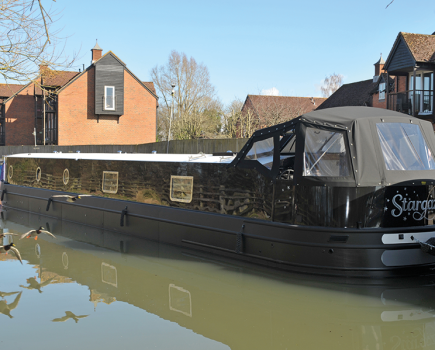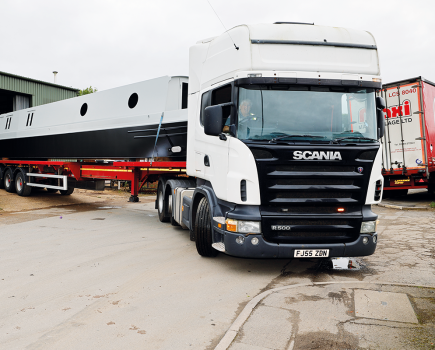Some do it from choice; others from necessity. Either way, operating a narrowboat single-handed needn’t be too daunting if you take care – and follow some useful advice

Boating single-handed might not be everyone’s idea of fun – although there are many who do enjoy it. But occasionally it might be a necessity, for example through injury or illness of a crew member, so it’s useful to have some idea of how to work a narrowboat on your own, just in case.
It might sound obvious but the first thing to think about when single handing is to ensure you carry out all the daily checks thoroughly before you set off. Of course you should do them anyway, but remember, once on the move you won’t have a handy crew member to nip inside to check something you might have missed doing. I find daily checks are best done first thing in the morning rather than last thing at night after all oil levels have settled and water coolant has cooled.
Before you go anywhere, check the engine and gearbox oil, cooling water filters and water coolant. Tighten down the sterngland greaser and make sure the engine stop button is fully closed. Always start the engine before untying any ropes: if for any reason it doesn’t fire up, you’ll still be safely moored rather than being halfway across the canal or river. Again, it’s a good idea whether or not you have crew to help, but when you’re on your own and there isn’t someone who can quickly grab a rope or a pole to help, it’s even more important.
If you have tied off using a bow, stern and centre rope, undo the bow rope first, then the stern and lastly the centre – it’s the one rope you can hold the whole boat with. Remember when you moor up to rings or bollards to always tie the ends of the ropes to the boat so that if the wind catches the boat and blows it away from the bank while you’re untying, you’ll be on the boat and not the bank.

If the wind is blowing the boat towards the bank, setting off can be tricky. With a crew to help they can stand on the bow with the bow rope still tied while you power the stern out. They can then untie their rope and push out the bow. But on your own, this isn’t practical – by the time you’ve pushed the bow out and got back to the stern, the boat might well have been blown back to the bank. Pushing the boat out from the middle isn’t much better: you then have to walk along the gunwale to the stern, and trying to do that quickly before the boat gets blown back is asking for an accident – with nobody on hand to help you out of the canal.
So the best way to set off is by what I call ‘springing the stern out’ (although I know there are other interpretations of this phrase). For more information about how to do this see Canal Boat April 2009, but basically it consists of four stages. n Engage reverse with the tiller pointing towards the bank, to get the stern out. n Engage slow forward with the tiller pointing away from the bank, but not enough to stop the boat going backwards. This will get the stern further out. Engage reverse with the tiller pointing away from the bank. This will pull the bow out from the bank. Engage forward, use enough tiller to straighten the boat, and off you go.
Having left your mooring, ensure your centre rope is on the roof, with its loose end at the stern of the boat, and on the towpath side. Remember to change this rope over when the towpath changes sides – or have two centre ropes, one each side. And make sure your centre rope is long enough so that you can work a lock without having to put it down.
Steering single-handed is no different from when you have a crew, but you do need to be more vigilant and think ahead, because you can’t send anyone to the bow to tell you if anything’s ahead. Make sure you have your canal guide or river chart at the stern and follow them. You may be approaching a sharp bend with a bridge so you will need to take your bow to the outside of the bend and give one long blast of the horn as a warning – a boat coming in the opposite direction should return the same signal.

When you reach a lock, moor your boat (and remember what I said about tying the ends of the ropes onto the boat) and then go to get the lock ready. Check if it has ladders on one or both sides, and see which one is the most convenient for you to use when getting on and off the boat. Have your centre rope ready, with its loose end to the stern, and on the same side as the ladder you are going to use.
Basic things to remember are:
To conclude, here’s a very useful hint that I’ve learned from other single-handed boaters. The centre rope is the most useful piece of equipment on your boat, but it must be attached at the right place. To check the correct position, stand on the bank and push the boat away. If the bow stays nearer the bank, move forward a little and try again. If the stern stays nearer the bank, move towards the back and try again. When you find a point where you can push the boat out without the bow or stern coming back to the bank, you’ve found the effective centre point of the boat. Attach the centre rope about 2ft forward of that point. Not only will it help you to control the boat, but if you should need to haul the boat on the rope it is more likely to travel straight, without either the bows or the stern pulling in towards the bank, if you tow it from that point.
Enjoy your boating, but do remember ‘the only way to go fast is to go slowly’ – especially if you’re single-handed.

Words by Terry Robertson, pictures by Marin Ludgate










Image(s) provided by:
Archant







